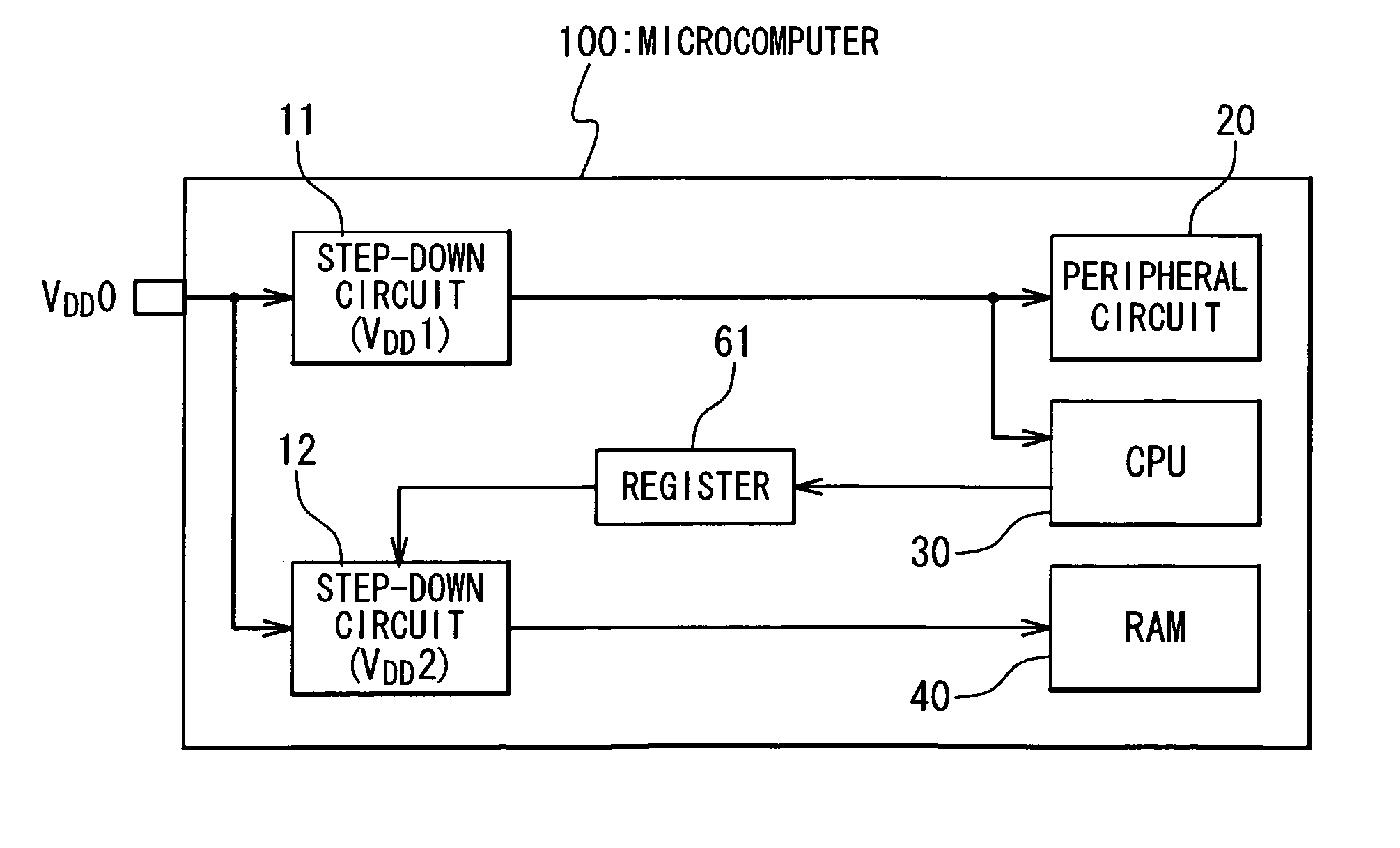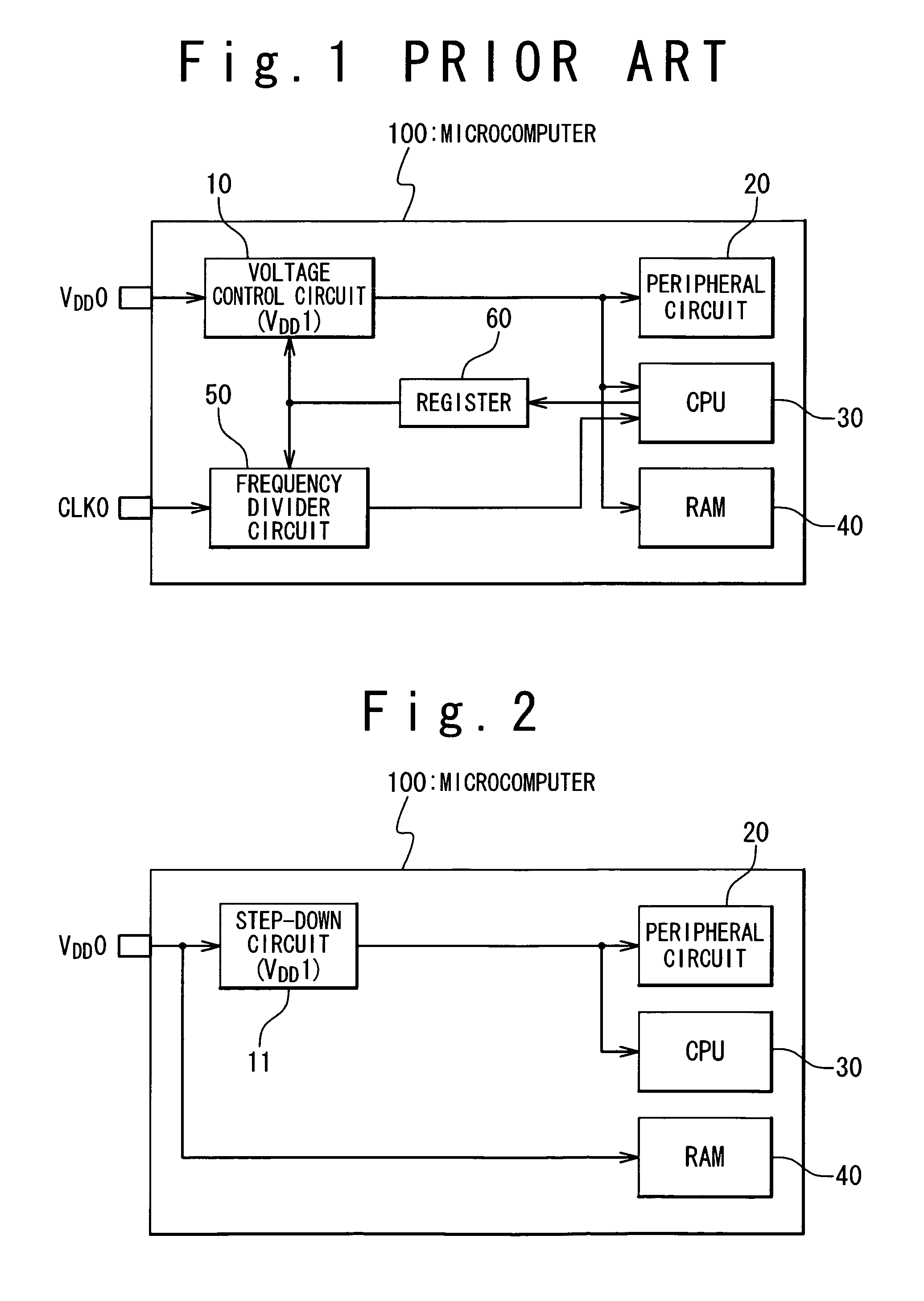Semiconductor device for reducing soft error rate with reduced power consumption
a semiconductor device and soft error technology, applied in emergency power supply arrangements, liquid/fluent solid measurement, instruments, etc., can solve the problems of increasing the soft error rate caused by the reduction of operation voltage, increasing the possibility of soft error in the ram, and increasing the possibility of electric charge generation, etc., to achieve the effect of reducing the soft error rate and reducing power consumption
- Summary
- Abstract
- Description
- Claims
- Application Information
AI Technical Summary
Benefits of technology
Problems solved by technology
Method used
Image
Examples
first embodiment
[0020]In a first embodiment, as shown in FIG. 2, a microcomputer 100 is provided with a step-down circuit 11, a peripheral circuit 20, and a CPU 30 and a RAM 40. The step-down circuit 11 generates an internal power supply voltage VDD1 by stepping down an external power supply voltage VDD0 fed to the microcomputer 100. The RAM 40 may be any semiconductor memory device. The RAM 40 may be a DRAM, an SRAM, an MRAM (Magnetic RAM), an FeRAM (Ferroelectric RAM), an OUM (Ovonic Unified Memory) and a flash memory. An EEPROM may be used instead of the RAM 40.
[0021]The step-down circuit 11 is connected to a power source terminal which receives the external power source voltage VDD0. The peripheral circuit 20 and the CPU 30 are connected to the step-down circuit 11. The RAM 40 is directly connected to the power source terminal; the power supply voltage is fed to the RAM 40 without interfacing with the step-down circuit 11.
[0022]The microcomputer 100 in the first embodiment is characterized in t...
second embodiment
[0025]FIG. 4 illustrates the structure of a microprocessor 100 in a The microcomputer 100 is provided with a step-down circuit 11, a peripheral circuit 20, a CPU 30 and a RAM 40. The RAM 40 includes multiple RAM blocks; in this embodiment, the RAM 40 includes two RAM blocks 41 and 42.
[0026]The step-down circuit 11 is connected to a power source terminal from which the external power source voltage VDD0 is supplied. The peripheral circuit 20, the CPU 30 and the RAM block 41 are connected to the step-down circuit 11. The RAM block 42 is directly connected to the power supply terminal receiving the external power source voltage VDD0, without interfacing with the step-down circuit 11.
[0027]The CPU 30, the peripheral circuit 20, and the RAM block 41 within the RAM 40 operate on the internal power supply voltage VDD1 generated by the step-down circuit 11, while the RAM block 42 operates on the external power supply voltage VDD0 which is higher than the internal power supply voltage VDD1....
fifth embodiment
[0035]FIG. 6 illustrates the structure of a microcomputer 100 in the present invention. The microcomputer 100 in this embodiment additionally includes a register 60 for controlling the step-down circuit 12. The value set to the register 60 is determined by the CPU 30.
[0036]In this embodiment, the internal power supply voltage VDD2, generated by the step-down circuit 12, is controlled in response to the value set to the register 60. In this embodiment, the internal power supply voltage VDD2 is decreased as the increase in the value set to the register 60. For example, the internal power supply voltage VDD2 is adjusted to be identical to the external power supply voltage VDD0 when the value set to the register 60 is “0”, while the internal power supply voltage VDD2 is adjusted to be VDD0-0.2 V, and VDD0-0.4 V, when the value set to the register 60 is “1”, and “2”, respectively. Setting a value of “0” to the register 60 provides the soft error reduction effect to the same degree as the...
PUM
 Login to View More
Login to View More Abstract
Description
Claims
Application Information
 Login to View More
Login to View More - R&D
- Intellectual Property
- Life Sciences
- Materials
- Tech Scout
- Unparalleled Data Quality
- Higher Quality Content
- 60% Fewer Hallucinations
Browse by: Latest US Patents, China's latest patents, Technical Efficacy Thesaurus, Application Domain, Technology Topic, Popular Technical Reports.
© 2025 PatSnap. All rights reserved.Legal|Privacy policy|Modern Slavery Act Transparency Statement|Sitemap|About US| Contact US: help@patsnap.com



